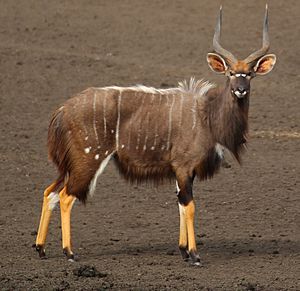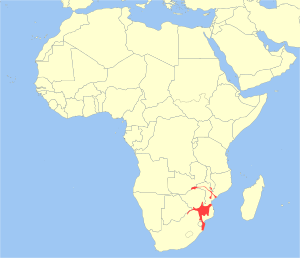Nyala facts for kids
Quick facts for kids Nyala |
|
|---|---|
 |
|
| Male | |
 |
|
| Female | |
| Conservation status | |
| Scientific classification | |
 |
|
| Geographic range | |
| Synonyms | |
|
The nyala (Tragelaphus angasii), also known as the inyala, is a type of antelope. These beautiful animals live in southern Africa. Nyalas are special because the males and females look very different from each other. This is called sexual dimorphism, and it's very noticeable in nyalas compared to other antelopes with spiral horns.
Nyalas are most active in the early morning and late afternoon. They are herbivores, which means they only eat plants. Their diet includes leaves, fruits, and grasses. They like to stay near water sources and prefer thick bushes and dense savanna woodlands over open areas.
Contents
Nyala Lifestyle and Behavior
Nyalas are not territorial, meaning they don't fight over specific areas of land. Older male nyalas often live by themselves. However, female nyalas and their young usually live in small family groups of up to ten members. These groups stick together in the dense thickets of dry savanna woodlands.
What Do Nyalas Eat?
As herbivores, nyalas enjoy a varied diet. They munch on fresh leaves from trees and bushes, sweet fruits, and different kinds of grasses. They always prefer to be close to water holes, which are important for drinking and finding food.
Who Hunts Nyalas?
The main predators of adult nyalas are large hunters like lions, leopards, and African wild dogs. Younger nyalas, called calves, face threats from smaller predators. These include baboons and raptors (birds that hunt, like eagles).
Nyala Reproduction
Nyalas usually have their babies during two main times of the year: in the spring and in the autumn. This is when most mating happens.
Where Nyalas Live
Nyalas are native to several countries in southern Africa. You can find them in Malawi, Mozambique, South Africa, Eswatini (formerly Swaziland), and Zimbabwe.
They have also been moved to other places. Nyalas were introduced to Botswana and Namibia. They were also brought back to Eswatini after they had disappeared from there in the 1950s.
Nyala Conservation Status
Good news! The number of nyalas in the wild is stable. Because of this, the International Union for Conservation of Nature (IUCN) lists them as a species of "Least Concern". This means they are not currently in danger of becoming extinct.
However, nyalas still face some challenges. The main threats to them are poaching (illegal hunting) and habitat loss. Habitat loss happens when their natural homes are destroyed, often because of human settlements expanding. Male nyalas are sometimes hunted for sport in Africa.
Images for kids
-
Male, two weeks old Tswalu Kalahari Reserve, South Africa
See also
 In Spanish: Nyala para niños
In Spanish: Nyala para niños











